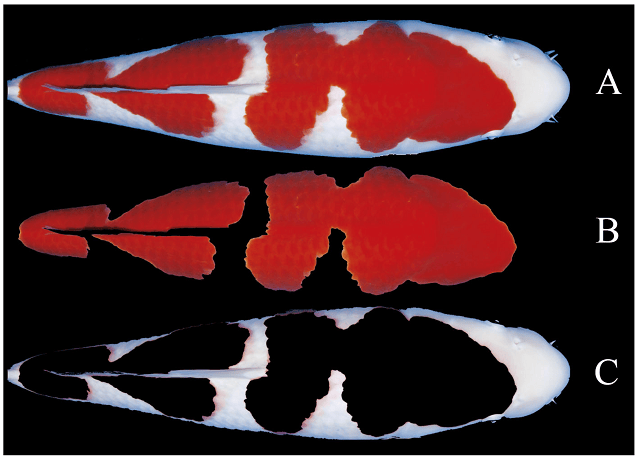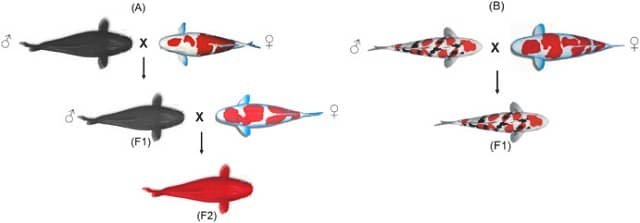
Koi fish, or carp koi, is the most famous ornamental variety of domesticated carp. Koi originated in Niigata Prefecture, Japan, after many generations of selective breeding.
The main characteristic of koi carp is their striking color patterns. Scale colors and color distribution patterns can vary widely among koi varieties, and the patterns are almost unique and nearly impossible to replicate between two individuals.
The evaluation of the quality of Kohaku Koi (Cyprinus rubrofuscus) is essential for the Koi industry. However, the community lacks knowledge about evaluating the quality of koi carp and their valuable characteristics.
During the “All Japan Nishikigoi Show” competition, the evaluation of koi quality is performed by experts. Judges use a 100-point system, where body shape and color represent 50% and 20% respectively, while color pattern, grace, and dignity represent 10% each.
Researchers from Niigata University analyzed the characteristics of Kohaku koi based on photos of participants in the “All Japan Nishikigoi Show” competition to analyze and discover the features that affect the quality of the Kohaku variety (Cyprinus rubrofuscus) of koi.
Image Analysis
Image analysis is used to solve different problems, such as counting the number of fish in a pond, determining the age of fish, or classifying fish.
By using image analysis to process photos containing useful data, complex problems can be solved.
The coloration of Kohaku carp is an important factor influencing fish quality, and image analysis is an appropriate method to obtain results that can explain the effect of features on the quality of Kohaku koi.
Structural characteristics of koi fish
“The results of this study showed that some structural and color characteristics of koi fish positively or negatively affect koi quality. For example, it was found that the body’s aspect ratio and the pale red coverage rate have a direct effect on Kohaku quality,” they report.
Stay Always Informed
Join our communities to instantly receive the most important news, reports, and analysis from the aquaculture industry.
According to the researchers, the results presented here provide a basis for future work on koi quality evaluation.
“In this study, only some of the body shape and coloration characteristics of Kohaku were analyzed. It was found that several of the analyzed characteristics have an impact on koi quality,” they described.
However, the researchers report that photos cannot convey complete information about the actual body shape of the koi, but only convey a restricted view due to the camera’s perspective.
Conclusion
“In this study, the body shape characteristics and coloration features of Kohaku koi were analyzed. We discovered and analyzed certain characteristics to determine their importance for Kohaku quality,” they highlight.
They also discovered that Kohaku with a fairly massive body was of higher quality.
“It was found that the feature with the strongest influence on Kohaku quality was the pale red coverage rate, with a high rate decreasing koi quality, and vice versa,” they conclude.
Furthermore, the researchers describe that based on this study, it is possible to perform similar analyses of body shape and coloration in other koi varieties.
“Further work is needed to improve the methodology of material collection for analysis, discover new characteristics of Kohaku’s body shape and coloration, enhance analysis quality, and study other koi varieties and their characteristics,” they concluded.
Recent studies conclude that crossing koi fish with Hungarian carp (Cyprinus carpio) can contribute to improving the shape and growth of koi carp.
Reference (open access)
Domasevich, Mikhail A., Hideo Hasegawa, and Tatsuya Yamazaki. 2022. “Quality Evaluation of Kohaku Koi (Cyprinus rubrofuscus) Using Image Analysis” Fishes 7, no. 4: 158. https://doi.org/10.3390/fishes7040158
Editor at the digital magazine AquaHoy. He holds a degree in Aquaculture Biology from the National University of Santa (UNS) and a Master’s degree in Science and Innovation Management from the Polytechnic University of Valencia, with postgraduate diplomas in Business Innovation and Innovation Management. He possesses extensive experience in the aquaculture and fisheries sector, having led the Fisheries Innovation Unit of the National Program for Innovation in Fisheries and Aquaculture (PNIPA). He has served as a senior consultant in technology watch, an innovation project formulator and advisor, and a lecturer at UNS. He is a member of the Peruvian College of Biologists and was recognized by the World Aquaculture Society (WAS) in 2016 for his contribution to aquaculture.




